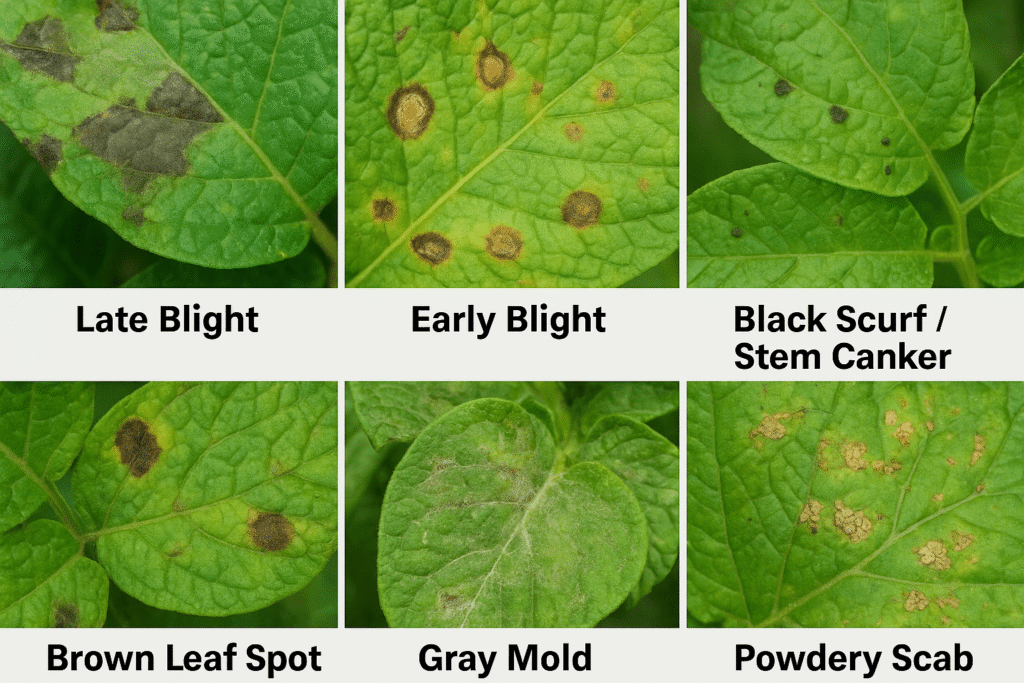
Diseases of potato are among the most serious threats to global potato production, causing yield losses of up to 80% if unmanaged. Potato (Solanum tuberosum) is one of the most important food crops worldwide and in Pakistan. However, its productivity is heavily affected by several fungal, bacterial, and soil-borne diseases. According to the International Potato Center’s Potato Pests and Diseases resource, diseases like late blight and bacterial wilt pose serious threats to global potato production. This article provides a comprehensive guide to the major potato diseases, including their symptoms, epidemiology, and the latest chemicals for control.
Table of Contents
ToggleMajor Diseases of Potato
Late Blight (Phytophthora infestans)
Symptoms
- Dark, water-soaked lesions on leaves and stems.
- White cottony fungal growth on the undersides of leaves during humid conditions.
- Tuber rot with irregular, brown, granular patches under the skin.
Epidemiology
- Disease thrives in cool (15–20°C) and humid (>90% RH) weather.
- Spread is rapid under rainy conditions.
- Pathogen survives in infected tubers and soil.
Control – Latest Chemicals
- Preventive sprays of mancozeb + cymoxanil.
- Curative fungicides: cyazofamid, dimethomorph, mandipropamid, and oxathiapiprolin mixtures.
- Systemic options: metalaxyl-M combined with contact fungicides for resistance management.
Early Blight (Alternaria solani)
Symptoms
- Small, circular brown spots on older leaves.
- Concentric ring patterns (“target spots”).
- Premature leaf drop and reduced photosynthesis.
Epidemiology
- Favors warm weather (24–29°C) with alternating wet and dry conditions.
- More severe in potassium-deficient soils and stressed crops.
Control – Latest Chemicals
- Azoxystrobin, pyraclostrobin, and fluopyram are highly effective.
- Rotation with chlorothalonil or mancozeb to avoid resistance.
- Use balanced NPK fertilizers to reduce disease severity.
Black Scurf / Stem Canker (Rhizoctonia solani)
Symptoms
- Black, irregular hard sclerotia on tuber surfaces.
- Poor sprouting or stolon pruning leading to patchy crop stand.
- Stem lesions near soil level.
Epidemiology
- Survives as sclerotia in soil for several years.
- Favored by cool, wet soils during germination.
Control – Latest Chemicals
- Seed treatment with fludioxonil, thiophanate-methyl, or pencycuron.
- In-furrow sprays of azoxystrobin before planting.
Brown Leaf Spot (Alternaria alternata and related fungi)
Symptoms
- Small brown lesions with yellow halos on leaves.
- Reduced leaf area leading to poor photosynthesis.
- Often confused with early blight but spots are smaller.
Epidemiology
- Occurs in warm and moderately humid conditions.
- More common in stressed or weak potato crops.
Control – Latest Chemicals
- Difenoconazole, tebuconazole, and boscalid sprays.
- Integrated management with crop rotation and resistant varieties.
Gray Mold (Botrytis cinerea)
Symptoms
- Gray, fuzzy mold growth on leaves and stems.
- Water-soaked lesions that later dry and kill tissues.
- Tuber infection in storage.
Epidemiology
- Disease spreads under cool, moist, and foggy weather.
- Fungus survives as sclerotia and conidia.
Control – Latest Chemicals
- Iprodione, fenhexamid, boscalid + pyraclostrobin mixtures.
- Preventive sprays at flowering stage.
Powdery Scab (Spongospora subterranea)
Symptoms
- Raised, warty lesions on tuber surface.
- Root galls that impair nutrient uptake.
- Acts as a vector for Potato Mop-Top Virus (PMTV).
Epidemiology
- Favors cool, wet soils with poor drainage.
- Resting spores survive >10 years in soil.
Control – Latest Chemicals
- No direct curative fungicides available.
- Soil fumigation with fluazinam and crop rotation reduces disease pressure.
Bacterial Wilt (Ralstonia solanacearum)
Symptoms
- Sudden wilting of plants without leaf yellowing.
- Brown vascular discoloration in stems.
- Bacterial ooze comes out when cut stems are placed in water.
Epidemiology
- Severe in warm, humid climates.
- Pathogen survives in soil and alternate weed hosts.
Control – Latest Chemicals
- No curative bactericides.
- Soil disinfection with bleach or lime.
- Resistant varieties and streptomycin sprays for secondary infections.
Soft Rot (Pectobacterium, Dickeya spp.)
Symptoms
- Watery, foul-smelling tuber rot.
- Stems may show black lesions at the base.
- Major post-harvest disease.
Epidemiology
- Spread during harvest wounds and humid storage.
- Survives in infected seed and debris.
Control – Latest Chemicals
- Post-harvest seed treatment with copper-based bactericides.
- Proper curing and cold storage at 4°C.
Common Scab (Streptomyces scabies)
Symptoms
- Rough, corky lesions on tuber skin.
- Does not usually reduce yield but lowers market value.
Epidemiology
- Favors dry, alkaline soils (pH > 6.0).
- More severe under drought stress.
Control – Latest Chemicals
- No effective fungicides available.
- Maintain soil pH 5.0–5.2.
- Irrigation during tuber initiation helps reduce incidence.
Similarities Between Potato Diseases
Some potato diseases have overlapping symptoms, making field diagnosis challenging:
| Disease | Similarity | Difference |
|---|---|---|
| Early Blight vs Brown Leaf Spot | Both cause brown leaf spots | Early blight has concentric rings (“target spot”), brown leaf spot has smaller, uniform spots |
| Late Blight vs Gray Mold | Both cause leaf lesions and thrive in humid conditions | Late blight shows white cottony growth, gray mold has gray fuzzy growth |
| Soft Rot vs Bacterial Wilt | Both caused by bacteria and lead to rotting | Soft rot affects tubers post-harvest, bacterial wilt causes plant wilting in the field |
| Black Scurf vs Common Scab | Both show symptoms on tuber surface | Black scurf shows black sclerotia, common scab shows corky lesions |
Integrated Disease Management for Potato
Use certified disease-free seed.
Crop rotation with non-host crops (3–4 years).
Balanced fertilization with adequate potassium and micronutrients.
Chemical control with fungicide rotation to avoid resistance.
Post-harvest management with proper storage at 4°C.
Conclusion
Diseases of potato remain one of the biggest threats to sustainable potato production worldwide. From late blight to bacterial wilt and soft rot, every stage of potato growth is vulnerable to different pathogens. The symptoms, epidemiology, and chemical control options outlined in this article provide farmers with a complete disease management plan. By combining resistant varieties, crop rotation, balanced fertilization, and modern fungicides, it is possible to protect potato yields and ensure high-quality tubers for the market.